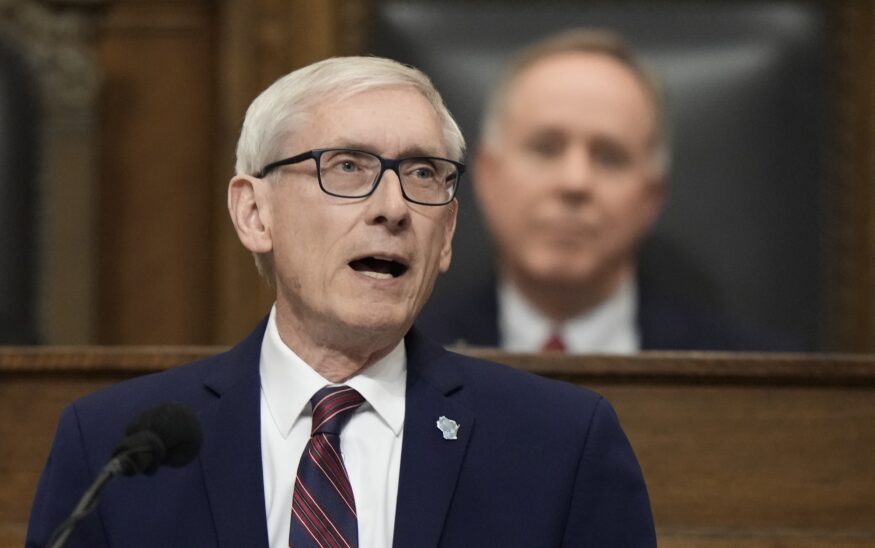Gov. Evers signs executive order creating Artificial Intelligence taskforce
By: Steve Schuster, [email protected]//August 25, 2023//
Gov. Evers signs executive order creating Artificial Intelligence taskforce
By: Steve Schuster, [email protected]//August 25, 2023//
Wisconsin Governor Tony Evers signed Executive Order #211 Wednesday, creating the Governor’s Task Force on Workforce and Artificial Intelligence.
As previously reported by the Wisconsin Law Journal, Evers announced earlier this month he is calling a special session of the Wisconsin State Legislature to take up his comprehensive plan to address the state’s longstanding workforce challenges. This task force will gather and analyze information and produce an advisory action plan to identify the current state of generative artificial intelligence’s (AI) impact on Wisconsin’s labor market and develop informed predictions regarding its implications for the near term and future. The action plan will also identify how these workforce impacts may affect Wisconsin’s key industries, occupations, and foundational skillsets, explore initiatives to advance equity and economic opportunity in the face of these changes, and based on the impacts identified, recommend solutions related to workforce development and educational systems, officials said.
“Wisconsin is ready to pursue and advance solutions that will ensure the state can take on the workforce challenges that may come with a transformative technology like artificial intelligence and embrace a future where all Wisconsinites, including workers, employers, and job seekers, benefit from a dynamic, growing economy that increases efficiency with the adoption of new technology,” said Evers.
“Establishing this task force will be critical in understanding, adapting to, and capitalizing on the transformations AI will bring, ensuring Wisconsin’s workforce and industries remain steady, stable, and robust in the face of technological advancement,” Evers added.
AI systems being produced today can learn from data without being explicitly programmed, create new content, predict future outcomes, and have the potential to reshape entire labor markets. Today, AI is increasingly being used in a range of industries important to Wisconsin, including manufacturing, healthcare, education, transportation, agriculture, and more. Yet, due to the novelty of the technology that is being developed and implemented, many Americans are concerned with or apprehensive of this emerging technology, with a Forbes 2023 survey reporting that more than 75 percent of “consumers are concerned with misinformation from artificial intelligence tools,” officials noted.
As the state continues ongoing efforts to address Wisconsin’s longstanding, generational workforce challenges, the Governor’s Task Force on Workforce and Artificial Intelligence will help ensure that Wisconsin remains competitive by establishing best practices for the implementation and utilization of AI technologies and identifying potential impacts of AI across industries, occupations, and skillsets with an eye toward greater equity and economic opportunity so all workers, employers, and job seekers in Wisconsin have the opportunity to benefit from this evolving technology, Evers added.
The Governor’s Task Force on Workforce and Artificial Intelligence will be administered by the Wisconsin Department of Workforce Development (DWD) and will be chaired by DWD Secretary Amy Pechacek or a designee. The governor will appoint additional members to serve on the Task Force, including Wisconsin Department of Administration Secretary Kathy Blumenfeld or a designee, Wisconsin Economic Development Corporation Secretary and CEO Missy Hughes or a designee, representatives from the University of Wisconsin and Wisconsin Technical College Systems, and other individuals who may include representatives from state and local government, the business community, educational institutions, organized labor, the technology sector, and other leaders from relevant workforce sectors and industries, according to officials.
July data from the U.S. Bureau of Labor Statistics show Wisconsin continues to see near record-low unemployment and record-high labor force participation.
“Still, Wisconsin’s small businesses, farmers and producers, hospitals and healthcare sectors, schools, and other critical employers and industries continue to face significant challenges filling available jobs. The governor’s plan would help reduce barriers to employment and prevent existing challenges from being exacerbated into an unmitigated crisis that would have calamitous consequences for Wisconsin’s workforce and help make sure the state can be successful and compete in the changing landscape of the global economic market,” officials said.
Legal News
- Wisconsin attorney loses law license, ordered to pay $16K fine
- Former Wisconsin police officer charged with 5 bestiality felony counts
- Judge reject’s Trump’s bid for a new trial in $83.3 million E. Jean Carroll defamation case
- Dozens of deaths reveal risks of injecting sedatives into people restrained by police
- The Latest: Supreme Court arguments conclude in Trump immunity case
- Net neutrality restored as FCC votes to regulate internet providers
- Wisconsin Attorney General asks Congress to expand reproductive health services
- Attorney General Kaul releases update at three-year anniversary of clergy and faith leader abuse initiative
- State Bar leaders remain deeply divided over special purpose trust
- Former Wisconsin college chancellor fired over porn career is fighting to keep his faculty post
- Pecker says he pledged to be Trump campaign’s ‘eyes and ears’ during 2016 race
- A conservative quest to limit diversity programs gains momentum in states
WLJ People
- Power 30 Personal Injury Attorneys – Russell Nicolet
- Power 30 Personal Injury Attorneys – Benjamin Nicolet
- Power 30 Personal Injury Attorneys – Dustin T. Woehl
- Power 30 Personal Injury Attorneys – Katherine Metzger
- Power 30 Personal Injury Attorneys – Joseph Ryan
- Power 30 Personal Injury Attorneys – James M. Ryan
- Power 30 Personal Injury Attorneys – Dana Wachs
- Power 30 Personal Injury Attorneys – Mark L. Thomsen
- Power 30 Personal Injury Attorneys – Matthew Lein
- Power 30 Personal Injury Attorneys – Jeffrey A. Pitman
- Power 30 Personal Injury Attorneys – William Pemberton
- Power 30 Personal Injury Attorneys – Howard S. Sicula












